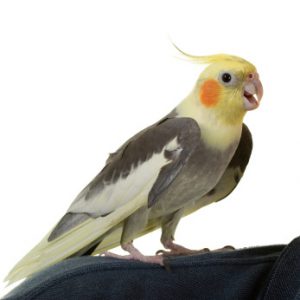Contents
 All of our small companion birds, even the low-key, relatively quiet cockatiel, can do the tricks that you see macaws, Amazons, and cockatoos do at theme parks. One main reason that the larger birds star in these shows is because the audience can see them better. It’s easiest to teach pet birds tricks that build on natural behaviors, which makes training cockatiels to turn around on cue, shake hands, and walk across a tightrope a possibility. With some practice and patience, you might be surprised by what your ‘tiel can do! Here are three fun tricks to try with your pet cockatiel.
All of our small companion birds, even the low-key, relatively quiet cockatiel, can do the tricks that you see macaws, Amazons, and cockatoos do at theme parks. One main reason that the larger birds star in these shows is because the audience can see them better. It’s easiest to teach pet birds tricks that build on natural behaviors, which makes training cockatiels to turn around on cue, shake hands, and walk across a tightrope a possibility. With some practice and patience, you might be surprised by what your ‘tiel can do! Here are three fun tricks to try with your pet cockatiel.
Train With An Edible Reward
You’ll probably get the best results in training if you offer your cockatiel a food reward. It needs to be a small offering that your bird is able to consume it quickly, so that you can continue your training session. Offer whatever you choose, such as a piece of hulled sunflower or a bit of spray millet, only as a reward. Do not include it in your bird’s regular diet.
Tricks To Train Your Cockatiel
1. Turn Around
Place your bird on a perch and put your finger below the bird’s beak, holding a treat. As your bird reaches for the treat, say, “Turn” or whatever word you’ll be using to ask your cockatiel to turn around in a complete circle, which is the eventual goal. You’ll need to work up to that behavior in small steps.
Once your bird is reaching for the treat, move it a little so your bird has to turn slightly to receive the treat. When your ’tiel does that, praise him and give him a treat. When your cockatiel has that down, move your finger some more, still below the bird, and heading toward his tail. Eventually your bird will have to turn around to get the treat you are holding behind him. At first you, will likely need to start with a treat below your bird’s beak and then move it to below his tail to guide your bird’s action. Your bird will follow that motion, naturally turning in the process.
Once your bird is turning around backward, start moving the treat back up to the starting point. Cockatiels usually catch onto this pretty quickly, and if you’ve used your command consistently, you can soon ask your cockatiel to turn or spin on command.
P.S.: Your bird will probably prefer to go around one direction or the other.
2. Shake Hands
Have a treat ready, and move your finger toward your cockatiel’s feet. Say, “Shake hands” or “how do you do?” or whatever you want to use as a voice command for this trick as you are near your cockatiel’s foot. Then move on to touching your cockatiel’s foot. Next, put your finger under a toe. Then several toes, and lift up. Your cockatiel might catch on anywhere along this progression. Be consistent in using your command. Perhaps curl your finger when asking your cockatiel to shake hands, as a visual signal that this is not “Step up,” for which the signal is a straight finger. Remember, cockatiels are very observant; eyesight is one of their strong senses.
Note: Most parrots are left-footed. Is your cockatiel offering you his left foot? It’s something to notice.
3. Walk a Tightrope
Walking along a rope is, of course, second nature to a cockatiel. They are meant to be climbing around in trees and swaying branches. But with the right pattern from you, it will look like a death-defying act to anyone watching your cockatiel do it.
Fashion a sturdy tightrope from two supports and some clothesline. You might try incorporating going up to one end of the tightrope via a ladder part of your trick. Lead your cockatiel with a treat at first, praising him for any progress from one support toward the other. Eventually, put your cockatiel on one side, and hold the treat at the other side, saying your command and giving your cockatiel a hand signal to ask him to walk the tightrope.
Praise your bird profusely for doing this trick when you ask.
Training Skills & Tips
Hold short training sessions and make them fun. If you or your bird becomes tired, find a way to end on a positive note, and stop working. There are no rules on how often you train or for how long, just what’s comfortable for you and your bird!
Props
Be creative and check out the hardware store and used toys. It could become a project to build your own prop, or it could help involve a family member with your bird.





